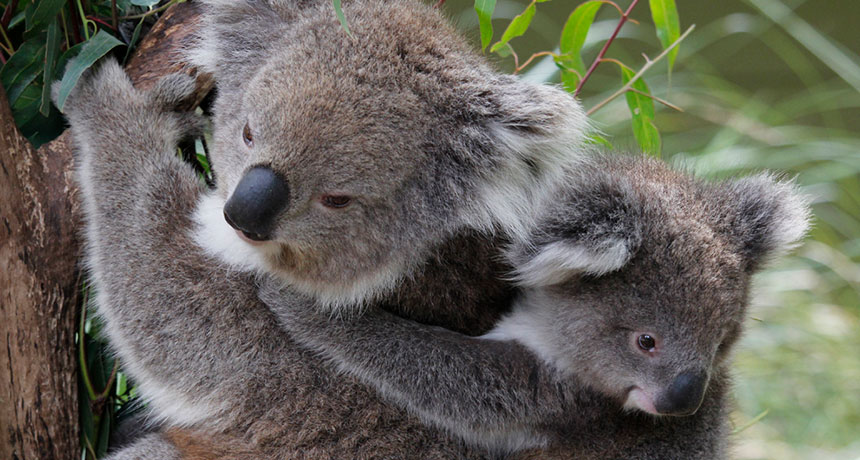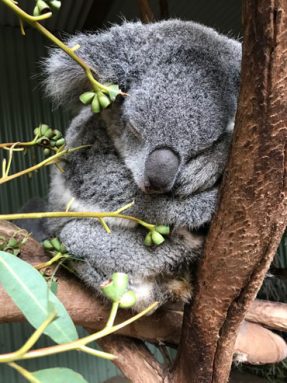Koala genes could help scientists save these furry animals
Details show why koalas are picky eaters and why their numbers are dropping

Scientists have mapped koalas’ genetic code. They hope its lessons will save these animals.
Robyn Cox/Flickr (CC BY-SA 2.0)
What’s the news? Researchers have now pieced together the genetic instruction books of koalas. The furry marsupials [mar-SOOP-ee-uhls] join a growing collection of creatures with fully sequenced genomes. Marsupials are mammals with pouches and include kangaroos, wombats and opossums. Marsupial mothers feed their tiny babies in those pouches after they’re born. The large group of researchers published their koala findings online July 2 in Nature Genetics.
Why do we care? Lots of people love koalas. Many people travel to Australia each year to see them. Those visitors bring in $1.1 billion (in Australian dollars) every year, according to the government of New South Wales, a state in Australia. But fewer koalas are surviving in the wild. What is in their genome could give scientists ideas about how to save them.
Already, scientists knew that koalas in some groups have more similar genes than koalas in other groups. (Animal groups with more gene differences are usually healthier.) Hills, rivers and other barriers can keep groups of animals apart. Animals that can’t mix often with others often have more similar genes.
Scientists also already knew that Australia’s Brisbane Valley and the Clarence River separated koala groups. The new work shows that the Hunter Valley is a barrier, too. Knowing which groups can’t mix as easily will help biologists. They can design new ways to keep koala genomes diverse.
How many genes does a koala have? 26,558. That’s almost twice as many as researchers had counted before. New techniques allowed scientists find more genes.
Is that a lot? Yes, especially for an animal. It’s 5,000 more genes than are found in humans. But plants often have thousands more genes than animals do.
The koala’s genome also has more DNA than the human genome. DNA is made from chemical building blocks called base pairs. Humans have about 6.4 billion DNA base pairs, but koalas have about 7 billion base pairs.

What else does the study reveal? Koalas eat eucalyptus [YOU-kuh-lip-tuss]. These plants make toxic chemicals called terpenes [TUR-peens]. Eating eucalyptus would kill most other animals. But koalas can break down these chemicals. They use extra copies of special CYP2C genes. These extra genes make proteins that break down chemicals in koala livers. These proteins can chop terpenes into smaller pieces that dissolve in water. Then the koalas flush the chemicals out in their pee.
But those genes may have a downside, too. They may make it harder to treat a disease in koalas. This disease called chlamydia [kluh-MID-ee-uh] is caused by microbes. Scientists have medicines to treat the disease. But the proteins that help koalas break down terpenes can also tear apart the chemicals in the medicines. That keeps them from killing the microbes.
Scientists are also learning why koalas are such picky eaters. Even though there are more than 600 species of eucalyptus, koalas dine on only about 20. Koalas have more genes connected with detecting bitter tastes (a total of 24) than other Australian marsupials. That’s useful for avoiding terpenes and other toxic chemicals. Koalas also have a souped-up sense of smell. They have six times as many genes involved in sniffing as other marsupials do. Together, the smell and taste genes may help koalas choose a healthy diet. They need a balance of nutrients and fewer toxic chemicals.
Koalas also have two copies of a gene called aquaporin 5. That gene helps them seek out the juiciest plant leaves. That’s important because koalas don’t drink much. They get most of their water from eating leaves.
Fun facts: On average, koalas sleep more than 14 hours each day. They also rest up to eight hours while awake. Koalas spend most of their active time eating, from four to seven hours. They only travel, on average, four minutes each day.
Koala mothers’ milk may help protect the babies in their pouches. The milk has proteins that fight diseases caused by microbes and fungi.







